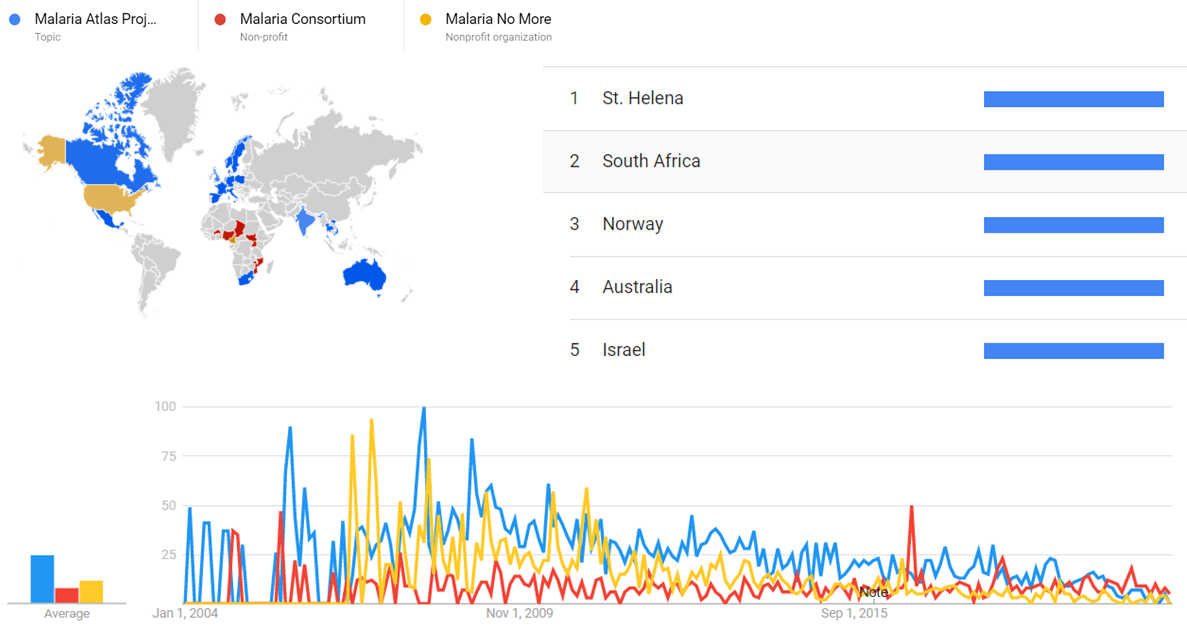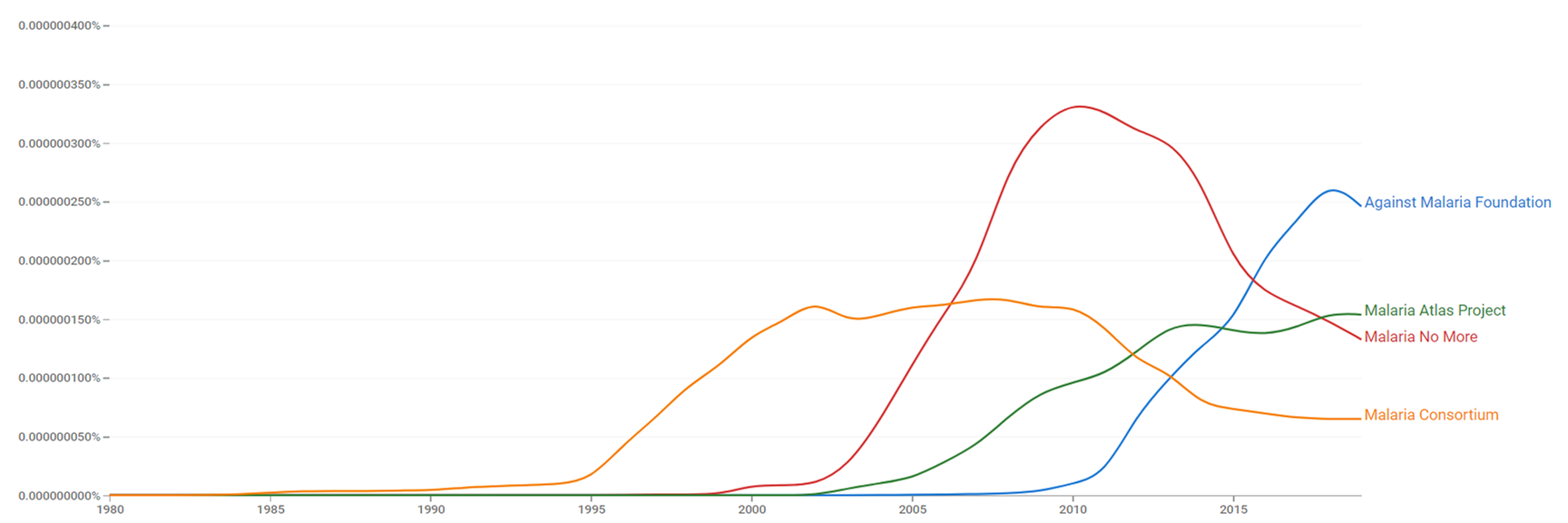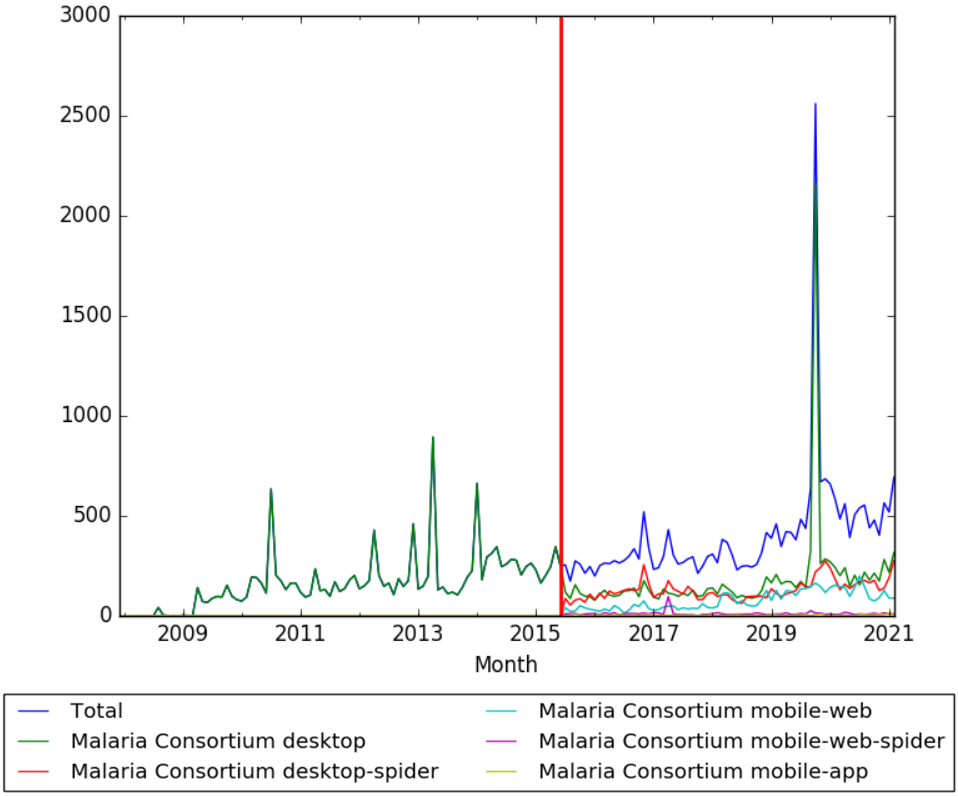Timeline of Malaria Consortium
This is a timeline of Malaria Consortium, a non-profit organization specialising in the prevention, control and treatment of malaria and other communicable diseases among vulnerable populations.[1]
Big picture
| Time period | Development summary |
|---|---|
| 1990s | Malaria Consortium grows out of the early 1990s when malaria is an extremely neglected disease, whose control is still suppressed by the backlash to the failed global eradication attempts of the 1960s.[2] |
| 2000s | First years. Malaria Consortium starts as a non-government organization (NGO).[2] The organization starts expanding into Asia and Africa. |
| 2010s | Malaria Consortium activities are increased due to support of donors, partners and collaborators from across the world.[2] In 2016, Charity evaluator GiveWell includes Malaria Consortium in its list of top charities for that year. |
Full timeline
| Year | Event type | Details | Location |
|---|---|---|---|
| 2003 (September) | Founding | Malaria Consortium is established as a non-government organization (NGO).[2][1] | |
| 2003 | Expansion | Malaria Consortium starts operations in Uganda.[3] | Uganda |
| 2004 | Founding | Malaria Consortium is officially launched, and holds its first organizational strategy meeting, including its founders Sunil Mehra, Graham Root, and Sylvia Meek.[2] | |
| 2005 | Expansion | Malaria Consortium starts operations in Myanmar, during the 2005 Malaria Programme Review.[4] | Myanmar |
| 2008 (March) | Expansion | Malaria Consortium opens an office in Thailand, to act as the regional headquarters for the Asia region.[5] | Thailand |
| 2008 | Expansion | Malaria Consortium opens country office in Nigeria. The organization would contribute significantly to the Roll Back Malaria needs assessment early in 2008, prior the start of SuNMaP project. Since then, seven offices (one in the capital Abuja and one in each of the six supported states) would be in charge of implementing SuNMaP project.[6] | Nigeria |
| 2008 | Mosquito net distribution | Over 1.1 million nets (including long lasting insecticidal nets – LLINs) are distributed to date by Malaria Consortium.[2][7] | |
| 2008 | Partnership | Malaria Consortium joins the Mekong Malaria Partnership, with focus on strategic information to support countries and partners in the Greater Mekong Subregion (GMS) to refine and improve their control strategies and to mobilize resources.[2] | Southeast Asia |
| 2009 | Program launch | Malaria Consortium starts implementing integrated community case management (iCCM) projects in Mozambique, South Sudan, Uganda, and Zambia.[8] | Mozambique, South Sudan, Uganda,Zambia |
| 2009 | Expansion | Malaria Consortium establishes an office in Phnom Penh, Cambodia, with field offices in Pailin and Rattanakiri (opened later in 2014). Since its inception, Malaria Consortium Cambodia would assist at both the provincial and national levels to strengthen the capacity of government officers and to provide technical support for malaria control and elimination.[9] | Cambodia |
| 2009 | Mosquito net distribution | At the end of the year, it is estimated that Malaria Consortium has protected over 18 million people from malaria through the provision of LLINs (mosquito nets impregnated with insecticide).[7] | |
| 2009 | Mosquito net distribution | Malaria Consortium distributes 4.5 million long-lasting insecticidal nets (LLINs).[2] | |
| 2010 | Exhibition | Acclaimed Malaria Consortium exhibition by Adam Nadel Malaria: blood, sweat, and tears launches at the United Nations in New York City.[2][10] | United States |
| 2010 | Drug distribution | Trachoma mass drug administration is carried out by Malaria Consortium in Unity state, Southern Sudan. Mass drug administrations are also carried out in the region for soil transmitted helminths and schistosomiasis, reaching over 30,000 and 24,000 beneficiaries respectively.[2] | South Sudan |
| 2011 | Program launch | Malaria Consortium starts working with the Ministry of Health’s Department of Medical Research to support the first artemisinin resistance containment baseline survey in Myanmar, which looks at growing resistance to antimalarial drugs.[4] | Myanmar |
| 2011 (July) | Program launch | The Malaria Prevention and Control project launches in Mozambique. Funded by the Global Fund to Fight AIDS, Tuberculosis and Malaria, it is implemented in partnership with World Vision as the principal recipient, with Malaria Consortium, Food for the Hungry (FH) and Fundação para o Desenvolvimento da Comunidade (FDC), International Relief for Development (IRD), and Médicos de Mundo de Portugal, as sub-recipients. The project aims to support the efforts of the Mozambican government to reduce malaria throughout the country through scale-up of prevention and control efforts with community involvement.[11] | Mozambique |
| 2011 | Partnership | Malaria Consortium becomes engaged in the Programme Partnership Arrangement (PPA) with the UK Government’s Department for International Development (DFID) for £2.67 million per year until March 2016. This strategic funding would enable the organization to pursue activities that they otherwise would not be able to, allowing to maximize impact.[12] | United Kingdom |
| 2011 | Mosquito net distribution | Malaria Consortium distributes 230,000 long-lasting insecticidal nets in Mozambique and a further 1.5 million through other partners.[2] | Mozambique |
| 2011 | Training | Malaria Consortium trains approximately 200 health workers in the use of intermittent preventive treatment of malaria for pregnant women in Uganda.[2] | Uganda |
| 2011–2017 | Endorsement | Malaria Consortium supports the provincial and district education directorates to train 1,682 teachers in 700 schools in the provinces of Niassa and Nampula in Mozambique, reaching approximately 31,289 students on a quarterly basis with key messages on malaria, prevention methods and the importance of care seeking.[13] | Mozambique |
| 2012 | Malaria Consortium manages to provide expertise on malaria prevention and control during the 2012 joint assessment of the response to artemisinin resistance in Myanmar and participates in the initial development of the Regional Artemisinin Initiative, supported by the Global Fund to Fight AIDS, Tuberculosis and Malaria. In the same year, the organization begins supporting the implementation and analyses of the first Myanmar Artemisinin Resistance Containment (MARC) survey.[4] | Myanmar | |
| 2012 | Training | Malaria Consortium trains more than 5,100 health workers across Africa programs from all levels in the health system receive training and nearly three million LLINs are distributed.[2] | Africa |
| 2013 | Expansion | Malaria Consortium is invited by the Myanmar Minister of Health to establish a permanent presence in the country, providing technical assistance for malaria control and in particular through monitoring and evaluation (M&E) activities.[4] | Myanmar |
| 2013 | Local retreat | Malaria Consortium closes its country office in Zambia.[2] | Zambia |
| 2013 (November) | Project | The project Pneumonia Diagnostics launches. It would cover Cambodia, Ethiopia, South Sudan, and Uganda. It consists in health workers using a number of devices to diagnose the symptoms of pneumonia in children under five years of age. These range from mobile phone applications, manual respiratory rate timers to coloured counting beads. Conducted by Malaria Consortium, the project is funded by the Bill & Melinda Gates Foundation.[14][15] | Cambodia, Ethiopia, South Sudan, Uganda |
| 2013 | Project | Malaria Consortium begins implementing a community-based seasonal malaria chemoprevention project in Katsina State, Northern Nigeria, with funding from the Bill & Melinda Gates Foundation. Extra funding is provided by UKaid from the British government through Malaria Consortium’s ongoing Support to National Malaria Programme (SuNMaP) project.[16] | Nigeria |
| 2014 | Project | The ACCESS-SMC (Seasonal Malaria Chemoprevention) project begins in the Sahel region. A UNITAID-funded project, led by Malaria Consortium in partnership with Catholic Relief Services (CRS), which supports National Malaria Control and Elimination Programs in seven countries (Burkina Faso, Chad, Guinea, Mali, Niger, Nigeria, The Gambia) leads the first-ever at-scale roll out of seasonal malaria chemoprevention (SMC).[17] UNITAID awarded US$67 million to Malaria Consortium to lead the project.[18] | Burkina Faso, Chad, Guinea, Mali, Niger, Nigeria, The Gambia |
| 2014 | Research | Malaria Consortium coordinates a study, aimed at exploring the barriers impeding the uptake of intermittent preventive treatment in pregnancy (IPTp) in Uganda. The research concludes that, despite a range of minor concerns, women and communities have largely positive views of antenatal care (ANC) attendance and IPTp. Refusal rates of IPTp are low and given the high ANC attendance figures, the main obstacles to the provision of IPTp are therefore likely to be supply-side challenges.[19] | Uganda |
| 2014 (December) | Expansion | Malaria Consortium establishes an office in Ouagadougou, Burkina Faso, as part of its ACCESS-SMC project.[20] | Burkina Faso |
| 2015 | Program launch | Malaria Consortium introduces the Integrated Community Case Management – Maternal and Child Survival (iCCM-MaCS) project in Uganda. Funded by British charity Comic Relief, the project aims at reducing the country's maternal and child health burden and to empower communities to take control of health issues within their communities.[13] | Uganda |
| 2015 | Partnership | Malaria Consortium, Raks Thai Foundation and Population Services Khmer begin collaboration on a program with aim at strengthening early detection and treatment of malaria through surveillance activities in Thailand and Cambodia. The project is supported by the Global Fund to Fight Aids, Tuberculosis and Malaria, the United Nations Office for Project Services and local malaria programs.[21] | Thailand, Cambodia |
| 2016 (May) | Expansion | Malaria Consortium establishes an office in N'Djamena, Chad, as part of its ACCESS-SMC project.[22] | Chad |
| 2016 (June) | Training | Malaria Consortium organizes the first training of volunteers in a project to improve their communities’ health service in rural Myanmar.[23] | Myanmar |
| 2016 (July) | Drug distribution | Malaria Consortium becomes the first organization to fully implement Seasonal Malaria Chemoprevention in Nigeria.[24] | Nigeria |
| 2016 (November) | Recognition | Charity evaluator GiveWell includes Malaria Consortium in its list of top charities for the year, for the consortium's work on seasonal malaria chemoprevention, and publishes a review of the consortium's work on that front.[25][26][27] | |
| 2017 (February) | Funding | Good Ventures awards a grant of US$5,000,000 to Malaria Consortium to support its seasonal malaria chemoprevention (SMC) program, in recognition of the program earning a "top charity" ranking from GiveWell.[28] | |
| 2017 (December) | Recognition | Malaria Consortium’s seasonal malaria chemoprevention program is recommended top-charity for second year in a row by GiveWell.[29] | |
| 2017 (December) | Funding | The Open Philanthropy Project recommends a grant of US$27,900,000 to Malaria Consortium to support seasonal malaria chemoprevention programs, due to its status as a GiveWell top charity.[30] | |
| 2018 (June) | Program launch | Malaria Consortium starts the Strengthening Uganda’s Response to Malaria (SURMa) project. Funded by aid from the Government of the United Kingdom, the project is implemented in eight districts across Uganda, and aims to improve access to — and uptake of — high-quality malaria prevention and control services.[31] | Uganda |
| 2018 (July) | Drug distribution | Malaria Consortium launches a new round of seasonal malaria chemoprevention distributions across Burkina Faso, Chad and Nigeria. The project is supported by Good Ventures and the target is set to reach over 4.3 million children with seasonal malaria chemoprevention across the three countries.[31] | Burkina Faso, Chad, Nigeria |
| 2018 (November) | Recognition | Malaria Consortium's seasonal malaria chemoprevention program is chosen as ‘top charity’ by GiveWell for third year in a row.[32][33] | |
| 2018 (November) | Funding | GiveWell allocates US$1.1 million in discretionary grant to Malaria Consortium's seasonal malaria chemoprevention program.[34] | |
| 2018 (December) | Funding | The Open Philanthropy Project recommends a grant of US$26,600,000 to Malaria Consortium to support seasonal malaria chemoprevention programs, due to its status as a GiveWell top charity.[35] | |
| 2019 (March) | Funding | GiveWell allocates US$7.6 million in discretionary grant to Malaria Consortium's seasonal malaria chemoprevention program.[34] |
Visual data
Google Trends
The comparative chart below shows Google Trends data for Malaria Atlas Project (Topìc), Malaria Consortium (Nonprofit) and Malaria No More (Nonprofit organization ), from January 2004 to March 2021, when the screenshot was taken. Interest is also ranked by country and displayed on world map. [36]

Google Ngram Viewer
The comparative chart below shows Google Ngram Viewer data for Against Malaria Foundation, Malaria No More, Malaria Atlas Project and Malaria Consortium, from 1980 to 2019.[37]

Wikipedia Views
The chart below shows pageviews of the English Wikipedia article Malaria Consortium, on desktop from December 2007, and on mobile-web, desktop-spider, mobile-web-spider and mobile app, from July 2015; to February 2021.[38]

Meta information on the timeline
How the timeline was built
The initial version of the timeline was written by User:Sebastian.
Funding information for this timeline is available.
Feedback and comments
Feedback for the timeline can be provided at the following places:
- FIXME
What the timeline is still missing
Timeline update strategy
See also
- Timeline of malaria
- Timeline of Against Malaria Foundation
- Combined timeline of malaria organizations
- Timeline of The Global Fund to Fight AIDS, Tuberculosis and Malaria
- Timeline of Malaria Atlas Project
- Timeline of mosquito net distribution
External links
References
- ↑ 1.0 1.1 "Who we are". malariaconsortium.org. Retrieved 13 December 2018.
- ↑ 2.00 2.01 2.02 2.03 2.04 2.05 2.06 2.07 2.08 2.09 2.10 2.11 2.12 2.13 "Malaria Consortium". malariaconsortium.org. Retrieved 31 January 2019.
- ↑ "Uganda". malariaconsortium.org. Retrieved 13 December 2018.
- ↑ 4.0 4.1 4.2 4.3 "Malaria Consortium in Myanmar". malariaconsortium.org. Retrieved 13 December 2018.
- ↑ "Thailand". malariaconsortium.org. Retrieved 13 December 2018.
- ↑ "Nigeria". malariaconsortium.org. Retrieved 13 December 2018.
- ↑ 7.0 7.1 "Annual Review 2008-2009". malariaconsortium.org. Retrieved 13 December 2018.
- ↑ "Connecting healthcare workers in rural Uganda with mobile technology". malariaconsortium.org. Retrieved 11 January 2019.
- ↑ "Malaria Consortium in Cambodia". malariaconsortium.org. Retrieved 13 December 2018.
- ↑ "Malaria: blood, sweat, and tears". malariaconsortium.org. Retrieved 1 February 2019.
- ↑ "Malaria Prevention and Control project". malariaconsortium.org. Retrieved 5 March 2019.
- ↑ "Programme Partnership Arrangement". malariaconsortium.org. Retrieved 13 December 2018.
- ↑ 13.0 13.1 "Blog". malariaconsortium.org. Retrieved 11 January 2019.
- ↑ "Pneumonia Diagnostics". malariaconsortium.org. Retrieved 13 December 2018.
- ↑ "The Pneumonia Diagnostics Project". stoppneumonia.org. Retrieved 13 December 2018.
- ↑ "Malaria Consortium's seasonal malaria chemoprevention projects in Africa". access-smc.org. Retrieved 25 October 2019.
- ↑ "ACCESS-SMC Impact: Three years of SMC in the Sahel". malariaconsortium.org. Retrieved 13 December 2018.
- ↑ "Malaria Consorium press release - $67 million grant for seasonal malaria chemoprevention". reliefweb.int. Retrieved 11 January 2019.
- ↑ "Barriers to IPTp uptake in Uganda". malariaconsortium.org. Retrieved 11 January 2019.
- ↑ "Burkina Faso". malariaconsortium.org. Retrieved 13 December 2018.
- ↑ "inFocus: Trans-border malaria programme Cambodia". malariaconsortium.org. Retrieved 11 January 2019.
- ↑ "Chad". malariaconsortium.org. Retrieved 13 December 2018.
- ↑ "Trained volunteers improve their communities' health service in rural Myanmar". malariaconsortium.org. Retrieved 11 January 2019.
- ↑ "Seasonal Malaria Chemoprevention: leading the way on an innovative approach in Nigeria". malariaconsortium.org. Retrieved 11 January 2019.
- ↑ "Malaria Consortium – Seasonal Malaria Chemoprevention". GiveWell. November 2016. Retrieved December 13, 2018.
- ↑ "Malaria Consortium placed as a GiveWell top charity". Malaria Consortium. November 29, 2016. Retrieved December 13, 2016.
- ↑ Dylan Matthews (November 29, 2016). "These are the charities where your money will do the most good". Vox. Retrieved December 13, 2018.
- ↑ "Malaria Consortium — Seasonal Malaria Chemoprevention". goodventures.org. Retrieved 19 April 2019.
- ↑ "Malaria Consortium's seasonal malaria chemoprevention programme is recommended top-charity for second year in a row". malariaconsortium.org. Retrieved 18 April 2019.
- ↑ "Malaria Consortium — Seasonal Malaria Chemoprevention (December 2017)". goodventures.org. Retrieved 19 April 2019.
- ↑ 31.0 31.1 "Malaria Consortium's 2018 highlights of the year". medium.com. Retrieved 11 January 2019.
- ↑ "Malaria Consortium programme chosen as 'top charity' by GiveWell for third year running". malariaconsortium.org. Retrieved 19 April 2019.
- ↑ "Malaria Consortium – Seasonal Malaria Chemoprevention". givewell.org. Retrieved 19 April 2019.
- ↑ 34.0 34.1 "Discretionary Grantmaking". givewell.org. Retrieved 19 April 2019.
- ↑ "Malaria Consortium — Seasonal Malaria Chemoprevention (2018)". goodventures.org. Retrieved 19 April 2019.
- ↑ "Malaria Atlas Project, Malaria Consortium and Malaria No More". Google Trends. Retrieved 30 March 2021.
- ↑ "Against Malaria Foundation, Malaria No More, Malaria Atlas Project and Malaria Consortium". books.google.com. Retrieved 30 March 2021.
- ↑ "Malaria Consortium". wikipediaviews.org. Retrieved 15 March 2021.